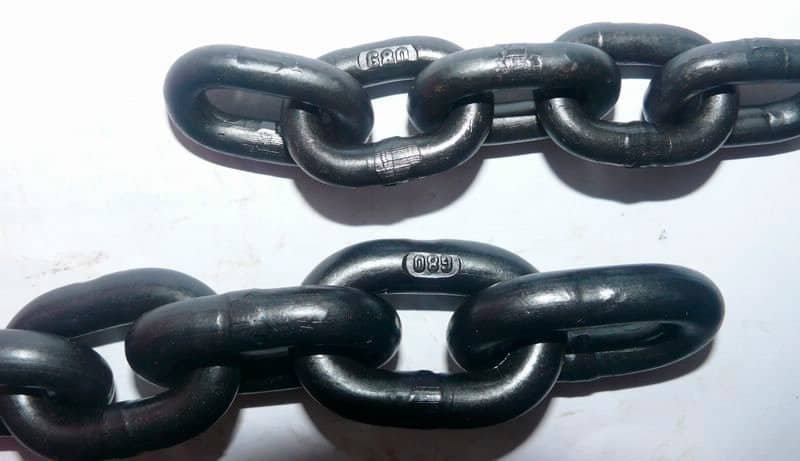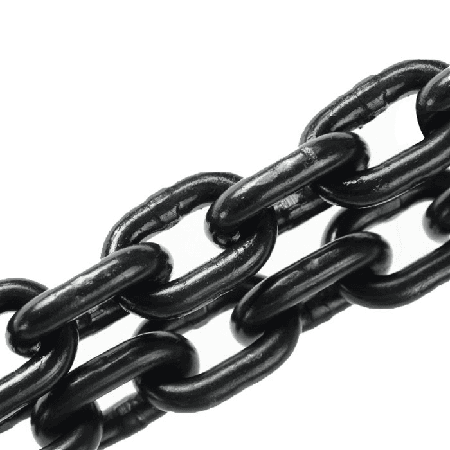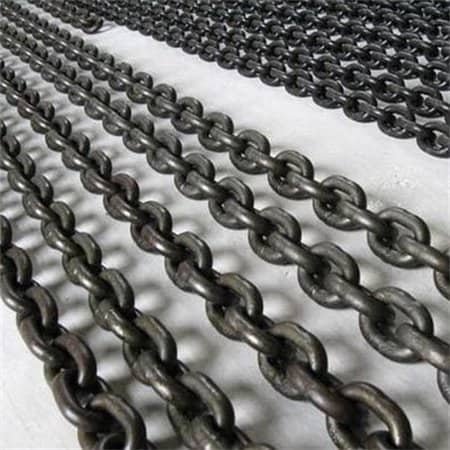G80 Lifting Chain vs G100 Lifting Chain
When it comes to lifting operations, choosing the right chain is crucial for ensuring safety, efficiency, and compliance with industry standards. Among the most commonly used lifting chains are G80 (Grade 80) lifting chains and G100 (Grade 100) lifting chains.
What Is a G80 Lifting Chain?

A G80 lifting chain is a high-strength alloy steel chain with a strength grade of 80. It is widely used in heavy-duty lifting applications due to its high load capacity and durability. G80 chains are manufactured to meet international safety standards such as EN 818-2.
✅ Key Features of G80 Lifting Chains:
- Strength Grade: Grade 80
- Material: High-strength alloy steel
- Surface Treatments: Black oxide, galvanized, or painted for corrosion resistance
- Operating Temperature: Typically suitable for -40°C to 200°C
🔧 Applications of G80 Lifting Chains:
- Construction sites
- Mining operations
- Dockyards and shipyards
- Industrial lifting operations
👍 Pros of G80 Lifting Chains:
- High load-bearing capacity
- Durable and wear-resistant
- Cost-effective for most lifting applications
⚠️ Cons of G80 Lifting Chains:
- Lower strength compared to G100 chains
- Heavier in comparison to higher-grade chains
- Limited performance in extreme environments
Parameter of G80 lifting chain

| Size(mm) | WLL/T | BL/KN | d(mm) | p(mm) | W1(mm)min | W2(mm)max | Weight(kg) |
| 4 | 0.5 | 20.1 | 4±0.16 | 12±0.4 | 5.2 | 14.8 | 0.35 |
| 5 | 0.8 | 31.4 | 5±0.2 | 15±0.5 | 6.5 | 18.5 | 0.5 |
| 6 | 1.12 | 45.2 | 6±0.24 | 18±0.5 | 7.8 | 22.2 | 0.8 |
| 7 | 1.5 | 61.6 | 7±0.28 | 21±0.6 | 9.1 | 25.9 | 1.1 |
| 8 | 2 | 80.4 | 8±0.32 | 24±0.7 | 10.4 | 29.6 | 1.4 |
| 10 | 3.2 | 126 | 10±0.4 | 30±0.9 | 13 | 37 | 2.2 |
| 13 | 5.3 | 212 | 13±0.52 | 39±1.2 | 16.9 | 48.1 | 3.8 |
| 16 | 8 | 322 | 16±0.64 | 48±1.4 | 20.8 | 59.2 | 5.7 |
| 18 | 10 | 407 | 18±0.9 | 54±1.6 | 23.4 | 66.6 | 7.3 |
| 19 | 11.2 | 284 | 19±1 | 57±1.7 | 24.7 | 70.3 | 7.8 |
| 20 | 12.5 | 503 | 20±1 | 60±1.8 | 26 | 74 | 9 |
| 22 | 15 | 608 | 22±1.1 | 66±2 | 28.6 | 81.4 | 10.9 |
| 26 | 21.2 | 849 | 26±1.3 | 78±2.3 | 33.8 | 96.2 | 15.2 |
| 32 | 31.5 | 1290 | 32±1.6 | 96±2.9 | 41.6 | 118 | 23 |
What Is a G100 Lifting Chain?

A G100 lifting chain is made from ultra-high-strength alloy steel and has a strength grade of 100. Compared to G80 chains, G100 chains offer a 25% higher load capacity. These chains are designed for more demanding lifting applications and are often used in harsh environments.
✅ Key Features of G100 Lifting Chains:
- Strength Grade: Grade 100
- Material: Ultra-high-strength alloy steel
- Surface Treatments: Often available in blue or orange coatings for additional corrosion resistance
- Operating Temperature: Suitable for use in a wider range of extreme temperatures
🔧 Applications of G100 Lifting Chains:
- Heavy machinery lifting
- Offshore lifting operations
- Wind turbine installation
- Specialized industrial applications
👍 Pros of G100 Lifting Chains:
- 25% higher load capacity than G80 chains
- Lighter weight for the same load capacity
- Better performance in extreme environments
⚠️ Cons of G100 Lifting Chains:
- Higher cost compared to G80 chains
- Not always necessary for general lifting operations
Comparison: G80 vs. G100 Lifting Chains
| Feature | G80 Lifting Chain | G100 Lifting Chain |
|---|---|---|
| Strength Grade | Grade 80 | Grade 100 |
| Material | High-strength alloy steel | Ultra-high-strength alloy steel |
| Load Capacity | Standard | 25% higher than G80 |
| Weight | Heavier | Lighter for the same load |
| Cost | More affordable | More expensive |
| Applications | General heavy-duty lifting | Specialized high-capacity lifting |
| Operating Temperature | -40°C to 200°C | Wider temperature range |
How to Choose Between G80 and G100 Lifting Chains
Choosing between G80 and G100 lifting chains depends on your specific needs and operational environment. Here are a few key considerations:
✅ Choose G80 Lifting Chain if:
- You need a cost-effective solution for general lifting operations.
- The lifting tasks do not exceed the load capacity of G80 chains.
- The work environment is not extreme in terms of temperature or corrosion.
✅ Choose the G100 Lifting Chain if:
- Your lifting operations require higher load capacities.
- You are working in harsh environments, such as offshore or high-temperature conditions.
- Reducing the weight of lifting equipment is important for your operations.
Safety Tips for Using Lifting Chains
- Regular Inspections: Always inspect lifting chains for signs of wear, corrosion, or damage before use.
- Avoid Overloading: Never exceed the working load limit (WLL) of the chain.
- Proper Storage: Store chains in a dry, clean environment to prevent corrosion.
- Follow Standards: Ensure that your lifting chains meet relevant industry standards such as EN 818-2 or ASTM guidelines.
Conclusion: Which Chain Is Right for You?
Both G80 and G100 lifting chains have their unique advantages. If you are looking for a reliable and cost-effective solution for most general lifting tasks, the G80 lifting chain is a great option. However, if your lifting operations demand higher load capacity and the ability to withstand extreme conditions, investing in a G100 lifting chain is a smart choice.


